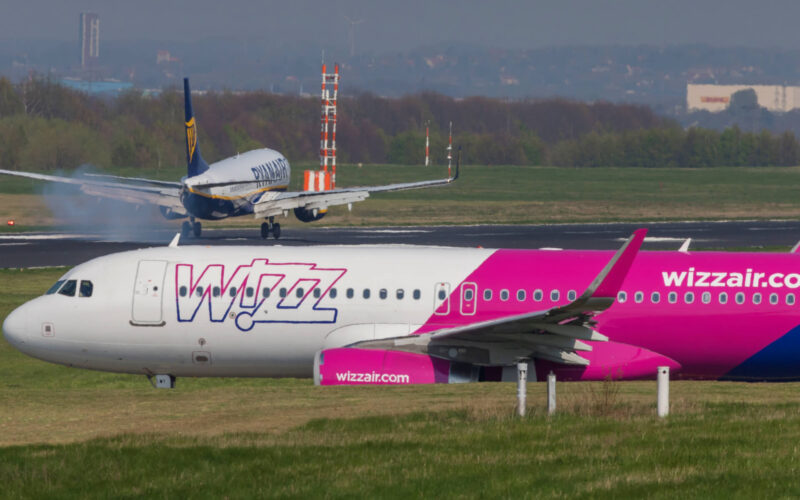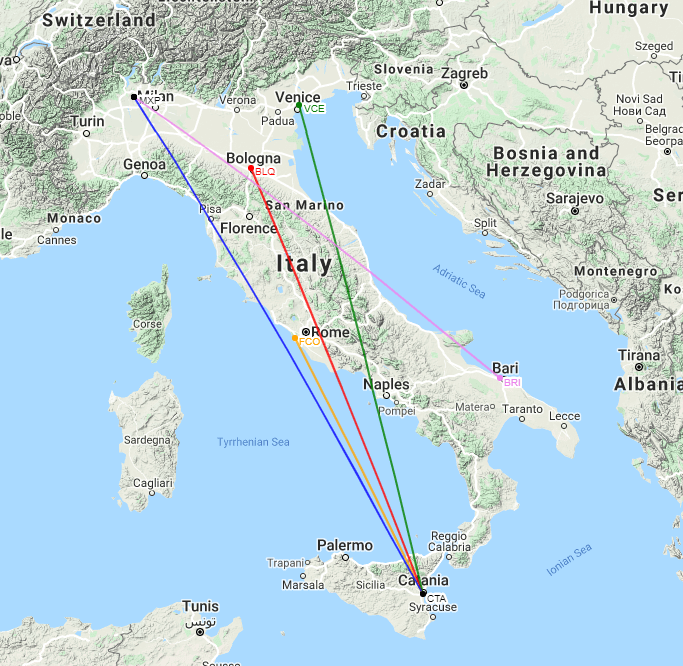The European low-cost carrier Wizz Air set an unprecedented precedent throughout the aviation industry. When other airlines were taking a step back, limiting their capacity and any expansion plans, the purple-colored airline announced 10 new bases. But seemingly, its tenth step was too far. Ryanair immediately responded to Wizz Air expansion plans – now, the two low-cost carriers dug out their trenches for a war of attrition in Italy.
On September 8, 2020, Wizz Air announced its tenth new base of 2020 in Catania, Italy. The second-largest city in Sicily will host two Airbus A321 aircraft from October 2020. From here, the carrier will offer flights to over 20 destinations available, five of which will be on newly-introduced routes. Catania Airport (CTA) would become Wizz Air’s second Italian base, as its first one is located in Milan Malpensa Airport (MXP).
Wizz Air will also introduce flights from Sicily to London Luton Airport (LTN) and Memmingen Airport (FMM) in Bavaria, Germany.
“The opening of a base at CTA by Wizz Air didn’t surprise me at all for two reasons,” argued Enzo Zangrilli, a senior aviation consultant at 1Aviation. Firstly, Catania is Sicily’s portal for leisure and business travelers.
“Secondly, Wizz Air has clearly shifted their strategy in the last six months by investing in an area (Western Europe) which previously wasn’t an explicit target, as showcased by its new bases in Cyprus, Milan Malpensa, and Tirana,” Zangrilli observed.
But judging by the response, it seemed like the Hungary-registered airline overstepped Ryanair’s boundaries.
The Irish response
Ryanair was very quick to react to Wizz Air’s impromptu move into CTA. Three days later, on September 11, 2020, the Irish low-cost carrier issued two press releases. Both of them had the same keywords in their titles ‒ Ryanair “responds to high demand by increasing flights […]”. At the forefront of the plans are domestic flights, as the Irish airline will increase the frequency of flights from Milan Malpensa Airport (MXP) to Bari Karol Wojtyła Airport (BRI) from three to nine per week. Meanwhile, Catania Airport (CTA) will see Ryanair’s presence grow by 28 additional weekly flights to Bologna, Milan, Rome, and Venice airports.
Both airlines are set to fly the new frequencies starting October 2020. With the exception of Ryanair increasing weekly frequencies from CTA to MXP, the two companies’ announcements are identical in terms of the increased capacity on Italy’s domestic flight network.
The Irish low-cost carrier increasing its capacity in the airport is no doubt a response to Wizz Air, noted Zangrilli. While it will benefit the consumer with lower ticket prices, “you can certainly argue that this situation is not sustainable and it only aims at ultimately making the other airlines bleed cash and withdraw from these routes.”
Ryanair is a very dominant force in Italy. The low-cost carrier is the largest airline in the country by a postcode. According to the Ente Nazionale per l’Aviazione Civile (ENAC), the civil aviation authority of Italy, the low-cost carrier welcomed 40 million passengers on its aircraft to and from the country. Alitalia, the second-largest airline in terms of passenger numbers, carried only 21.7 million travelers in 2019.
Filling opening gaps
Within the previous year, two gaps have opened over the skies of Italy. In December 2019, Ernest Airlines, a small Italian low-cost carrier with a fleet of four Airbus A320 family aircraft, was publicly threatened by ENAC. The authority requested the company to provide documents regarding its financial situation if it wanted to retain its operating license. The authority gave Ernest Airlines two weeks to resolve the issue.
Resolve the issue it did not – on January 13, 2020, the airline switched off its engines for the last time. Despite being hopeful to resolve the issue and restart operations, based on an issued statement, an aircraft bearing Ernest Airlines’ livery has not yet taken off since then.
The second victim was Air Italy, which abruptly stopped its operations in February 2020. Alleged differences between the two shareholding parties, namely Alisarda and Qatar Airways, was the final nail in Air Italy’s controversial coffin. The latter shareholder was accused of using the Italian company to violate the Qatar-United States Open Skies agreement, whereupon the two countries agreed that Qatar would not instate fifth-freedom flights and only operate direct flights between the two.
Despite what appeared like a traditional Italian fashion of running airlines at a loss, the Boeing 737 MAX crisis affected Air Italy heavily as its expansion plans were dependent on the MAX. By 2022, half of its fleet was supposed to be the still-grounded narrow-body. Combined with the alleged investors’ conflict, its days were numbered.
Throughout 2019, Air Italy and Ernest Airlines carried 2.1 million and 0.9 million passengers, respectively, leaving a sizable gap in the market. After Ernest Airlines’ collapse, Wizz Air immediately pounced on the opportunity to fill the void and introduced flights from Albania’s capital Tirana to five Italian cities. The collapsed Italian carrier operated more than 40% of the total capacity between Italy and Albania, while Air Italy left room to wiggle in extra flights.
Furthermore, the struggling Alitalia is also looking to downsize as it is restructuring under its newly-established company, the “new” Alitalia. Local media reported on September 14, 2020, that the national flag carrier was withdrawing from Milan-Malpensa and instead focusing on the other airport in the city, Linate (LIN). This move would free up crucial space in MXP, where slot assignment is mandatory, according to Assoclearance, Italy’s airport slot coordinator.
In 2019, Wizz Air was the sixth-largest airline in Italy in terms of passenger numbers. However, the Italian domestic market was non-existent in the carrier’s network: out of the total 5.1 million travelers to and from Italy on the airline’s aircraft, 100% of those travelers landed or departed outside of the country. Ryanair, in terms of domestic traffic, was the second-largest airline in Italy, trailing behind the restructuring and ailing Alitalia.
There is no doubt that the two have the capability and the need to fight a war of attrition in the Southern European country.
Crucial market
Entering the crisis and throughout it, both Ryanair and Wizz Air have emphasized the fact that they have cash for days. The Irish carrier ended June 2020 with a net cash balance of €3.9 billion ($4.6 billion) and debt-free 333 Boeing 737 aircraft, valued at €7 billion ($8.2 billion), according to the company’s latest financial update. Wizz Air, meanwhile, ended the same period with €1.6 billion ($1.8 billion) of cash. The Hungarian airline, smaller in scale than Ryanair, had a fleet of 123 aircraft. In total, the Irish company owned 470 aircraft.
The two have largely avoided taking in state-aid while other airlines throughout the continent turned to their respective governments to weather the current crisis. But as loud as Ryanair was in criticizing others regarding governments giving out cash to airlines, the low-cost carrier applied for the United Kingdom’s COVID Corporate Financing Facility (CCFF) and received £600 million ($779 million). Wizz Air received £300 million ($389 million) from the same financing facility, bolstering its liquidity going forward.
At the start of the crisis, both companies’ chief executives were again, loud and clear regarding their cash balance. On March 20, Ryanair’s Michael O’Leary stated that the company had enough cash to not fly for 12 months and still come out unscathed, as reported by Reuters. On March 16, Wizz Air’s József Váradi told the Hungarian media that the airline could finance itself for three years without flying a single flight.
Italy’s flight activity has been on a steady rise, according to EUROCONTROL, the coordinator of Air Traffic Control above Europe’s skies. In March 2020, Italy’s monthly traffic dropped by 65.9%, by far the worst result in the continent – with the same trend continuing throughout April and May. By June, however, the market has started to recover – if in April flight activity in Italy was 92.1% lower than in the same month in 2019, by August 2020, the number recovered to 49.1%. EUROCONTROL data points out that the average number of flights during the same month in Europe was 51.5% lower.
Where two are fighting, a third one wins. At least the old expression will be tested in Catania, as easyJet also announced its plans to increase flights from MXP to CTA and BRI, two airports where both Ryanair and Wizz Air have increased their frequencies.
“Italy is the European country with the highest low-cost carrier penetration, due to a structurally weak national carrier but also because Italy is Italy, a market good for both Business and, of course, leisure,” commented on the market situation Zangrilli. Domestic and intra-European will undoubtedly recover first, and “positioning yourself as the strongest LCC domestically and on short-haul routes will help pay the bill in the next 24 to 36 months,” concluded Zangrilli.


